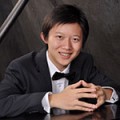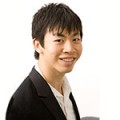Proteges and polymaths to perform in Alaska piano competition
April 25, 2014
907-474-2417
04/25/14
After a demanding application process, 24 of the most talented young pianists the world have been selected to travel to the University of Alaska Fairbanks to compete in the Alaska International Piano-e-Competition, June 28 – July 12, in the Davis Concert Hall.
The competitors range in age from 19 to 31 years old. They hail from 13 countries, including the United States, China, Costa Rica, Denmark/Sweden, Finland, Germany, Kazakhstan, Russia, South Korea, Spain, Taiwan and Ukraine. Many have already placed in at least one international competition, and they perform solo and with orchestras around the world.
Protégés

Many competitors began their studies very early in life.
Frank Dupree of Germany began studying piano at age 6 and was admitted to study at the University of Music in Karlsruhe around age 10. At age 13, he performed Tchaikovsky’s “Piano Concerto No. 1 in B-flat Minor” with the Nancy Symphony Orchestra in France. At age 16, Dupree was a first-place winner of this competition’s junior sister, the Minnesota International Junior Piano-e-Competition.

Hyejin Kim began her piano studies at age 5. She entered Seoul’s Yewon Arts School, the most famous in Korea. In 2004, she began showing her musicality through international festivals and competitions in Shanghai, the United States, the Netherlands and Italy. In 2005, she was the youngest third-prize winner in history of the Busoni International Piano Competition.

The youngest competitor is Chen Guang, 19, born in China’s Hubei province in 1994. He began studying piano at age 4 with his father and at age 12 was admitted to the Central Conservatory in Beijing. His European debut was made touring Germany for recitals in 2011. Since 2012, he has lived and studied in Italy.
Polymaths

Though each competitor is deeply skilled in concert piano, many are gifted in other areas.
Competitor Lindsay Garritson of New Haven, Conn., began performing in the United States and abroad at age 4. A gifted swimmer and multi-talented musician, she is also a violinist and singer, but she decided to pursue being a concert pianist when she was 11. During an interview related to her participation in the prestigious Van Cliburn international competition, she said, “The defining moment — when I decided I really wanted to do piano — was when I went to a summer music festival. That was the summer I turned 11. I remember being so inspired by hearing all the different pianists that were my age. For some reason, something really clicked, and I decided that I was going to be a pianist.”

Peter Friis Johansson is a keen performer of contemporary music across Scandinavia, premiering more than 15 new works by Thea Musgrave, Mirjam Tally and Andrea Tarrodi. He was also a member of the now-defunct ensemble NordicFusion6, which performed new works and was supported by the Nordic Council of Culture.

Californian Martin Leung is perhaps most widely known as the Video Game Pianist – in 2004, a video of Leung playing the theme to the Nintendo game Super Mario Bros while blindfolded went viral on the website eBaum’s World, garnering views by an estimated 40 million people. Leung began recording more classical renditions of popular video game music, eventually being invited to perform these arrangements as a classical pianist at numerous video game expositions and conferences around the country.
Performances
Each of these pianists is preparing and polishing performances for each of four rounds of competition. All performances will be played on a Yamaha Disklavier, a special Internet-connected piano that sends the precise keystrokes and subtle pedal movements to other networked Disklaviers around the world. The networked pianos play in sync with the competitor in real time, as if the pianist was invisible at the keys.
In the first round, which lasts five days, competitors present a 65- to 75-minute program of their own selection, performed completely from memory. Based on these performances, 10 competitors will be selected by the international jury to progress to the second round.
In the second round, each competitor performs a choice of Schubert’s major sonatas. One competitor will be awarded the Schubert Prize and five will be selected to progress to the third and fourth rounds of the competition.
Solo performances and chamber music are the focus of the third round. Each competitor will present a 30-minute solo performance of a selection of their choice, as well as a selection of one of three chamber music pieces: Cesar Frank’s “Violin Sonata in A Major,” performed with Kathleen Butler-Hopkins, professor of violin, viola and chamber music at UAF; Johannes Brahms’ “Cello Sonata in F Major, Op. 99,” performed with Karl Knapp, assistant professor of cello and low strings at UAF; or Robert Schumann’s “Dichterliebe, Op. 48,” performed with Jaunelle Celaire, associate professor of voice at UAF.
The final round of competition spans two evenings. Each competitor will choose and perform a piano concerto with the Fairbanks Symphony Orchestra. An international jury will determine the winners of the first-, second-, third-, fourth- and fifth-place prizes, to be announced at the award ceremony and concert on Saturday, July 12. The concert will feature a final performance by the winner with the Fairbanks Symphony Orchestra.
The competition begins on June 28 with a welcome party and drawing of the lots. The first round begins on June 29. Volunteers are needed to help run the competition, as are families interested in providing additional hospitality and support to competitors. To learn more about opportunities to make a gift or volunteer for the competition, view the performance schedule, read competitor and judges’ biographies, or to purchase tickets, visit the competition’s website at http://www.uaf.edu/piano.
KP/4-25-14/295-14


